7+ SAMPLE Staff Training Agreement
-
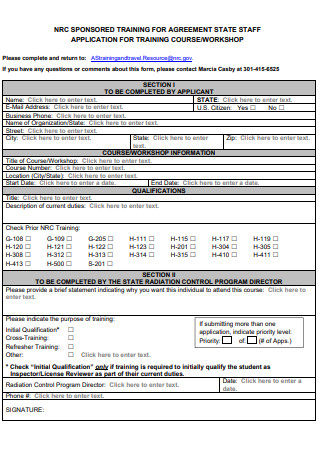
Staff Workshop Training Agreement
download now -
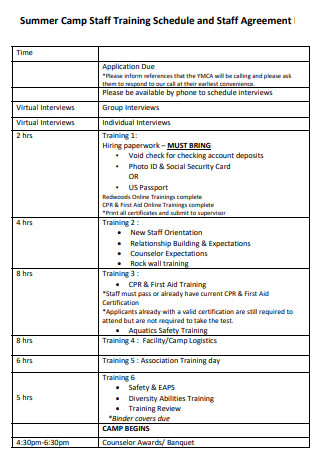
Summer Camp Staff Training Agreement
download now -
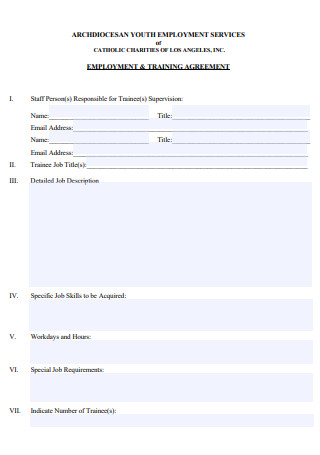
Staff Employment Training Agreement
download now -
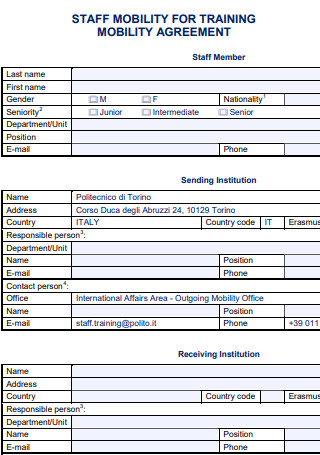
Staff Mobility Training Agreement
download now -
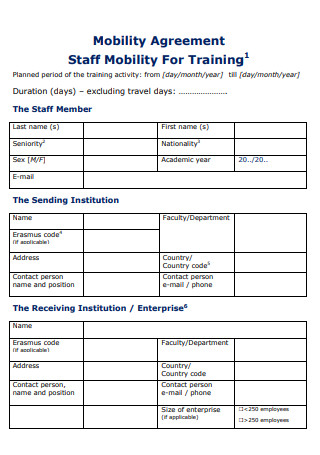
Mobility Agreement for Staff Training
download now -
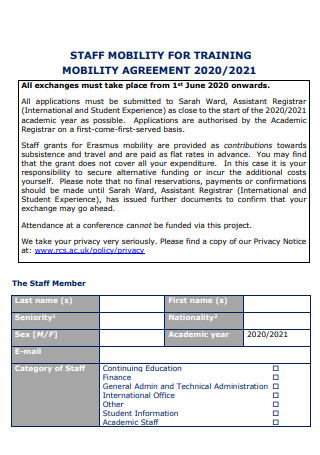
Staff Member Mobility Training Agreement
download now -
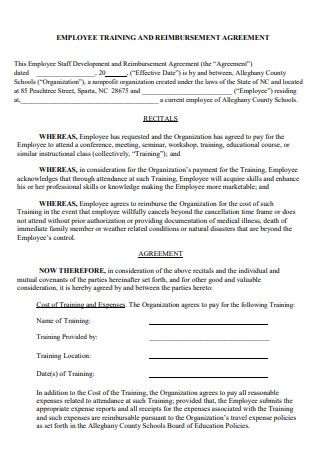
Employee Staff Training Agreement
download now -
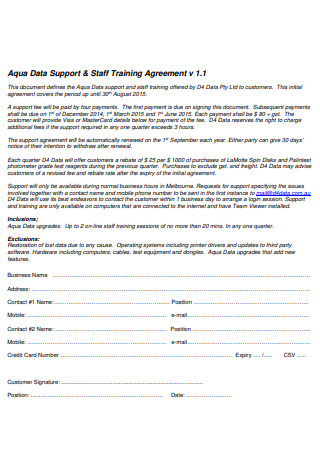
Data Support Staff Training Agreement
download now
FREE Staff Training Agreement s to Download
7+ SAMPLE Staff Training Agreement
a Training Agreement?
Benefits of Staff Training
How To Develop a Successful Staff Training Program
FAQs
Is it possible to enforce training contracts?
What information should be included in a training agreement?
Is it possible for my boss to refuse to offer me a day off?
What Is a Training Agreement?
A training agreement is a formal contract between an employer and an employee that details the terms and conditions of any training. It will describe the cost of training, who provides it, and who is initially responsible for paying for it. However, and perhaps most crucially for employers, it can be used to specify when an employee may become accountable for reimbursing any of those training expenditures and how that payback would occur. It can also determine whether such costs become reimbursable if an employee leaves the company shortly after finishing the training. According to statistics, employees value training opportunities at least as much as their employers do, and 34% of employees are delighted with their job-specific training, even though 41% view it as critical.
Benefits of Staff Training
In the twenty-first century, they altered both the functionality and mentality of society. There was a period when employees were expected to contribute to the businesses’ performance via applying their knowledge and talents. However, firms today offer training programs to their employees and help them grow their abilities. It enables businesses and their employees to grow and advance. The following are the primary benefits of employee training for business companies.
How To Develop a Successful Staff Training Program
Establishing a corporate learning program is not difficult. However, developing a well-defined employee training program takes time. Being proactive and developing a well-thought-out approach simplifies, streamlines, and most importantly, makes it achievable. To assist you in creating a workable staff training program in which you understand your objectives and have the resources necessary to accomplish them, we’ve compiled this list. We’ve defined six critical actions that will assist you in developing a plan that works for you progressively.
Step 1: Analyze your training requirements.
Your organization is currently engaged in some staff assessment, whether you are aware of it or not. It might be official – such as in-person training or eLearning – or informal – such as infrequent, casual education among coworkers. Before you go in and begin preparing or adding to it, you must ascertain what, when, and where everything is taking place. Many firms skip this phase, which causes them to miss the mark since they haven’t taken the time to determine the type of training required by the organization. However, after conducting an in-depth analysis of your existing training plan, you’ll have a far more precise concept of your learning objectives. Thus, what is the scope of your research? It would help if you went into the weeds of what is truly happening within your organization during your study.
Step 2: Develop a plan to address training gaps.
You’ll begin to find training shortages inside your business as a result of your investigation. You’ll notice where your employees are succeeding and where a leaky training bucket needs to be patched. Now is the moment to strategize about how you will close these gaps. You’re likely to unearth a plethora of educational opportunities. However, depending on your resources, you may not be able to construct courses for everyone immediately. It would help if you established priorities. To achieve this, create a list of all the training that your organization need or desires. Then prioritize what is most critical. It is totally up to you to choose what is most urgent.
Concentrate on a trend of poor onboarding. Or, if you’re responsible for delivering company-wide compliance training, it’s a no-brainer that this should be your priority. It is entirely dependent on your organization and intended outcomes. Also, your training plan should address how you intend to deliver training. Are you planning to use an LMS exclusively or a blended learning model? How are you going to evaluate your students? What instruments are required to provide training? The more you delve into the weeds and address these questions, the smoother the process will be in the long run.
Step 3: Invest in the instruments and resources that you require.
A critical component of your training strategy is investing in the tools necessary to deliver practical training. The most vital element is a learning management system (LMS) that manages, offers, and tracks your employees’ activity and development. From the analysis and preparation described above, you should be able to create a solid outline of what you want from your LMS with which to begin your search. Bear in mind that you do not need to purchase every tool immediately. We recommend that you prioritize your urgent needs and then construct a toolset as you go. This guarantees that you’re just utilizing the essential tools and deriving the maximum benefit from each.
Step 4: Create the content for your course.
A standard error made by businesses is underestimating the amount of time and work required to generate course content. Training courses require some planning because there are numerous spinning plates. To begin, browse through existing stuff. You’d be astonished at how much information may be recycled within your organization. From face-to-face training presentations and handouts to individual team guides, developing eLearning courses using existing materials is an excellent way to get started. Also, consider external avenues. YouTube videos, podcasts, and industry reports are all examples of content that can be included in your training.
If you’re starting from scratch, a good place to start is with your organization’s subject matter experts. Cooperate with them and ask their advice on the most effective methods for training on a particular subject, how to assess your learners, and how to arrange the course, among other things. This simplifies the process of content development.
Step 5: Carry out your training.
With the LMS in place and the training materials completed, you can finally begin implementing your training program. There are a few principles you should follow to maximize your chances of success. To begin, while it may be tempting to enroll all of your learners in a course simultaneously, this is not the ideal course of action. Rather than that, begin your training gradually. Add a few classes to your LMS and enroll a representative sample of your staff. This sample group will serve as your guinea pigs, and if anything goes wrong, you’ll have time to iron out the wrinkles before adding the larger organization. Likewise, this holds for your LMS’s features. Begin with simple workflows and then add more advanced ones. In this manner, you’ll be able to gauge how your users genuinely feel about the LMS and its material. After a while, you can begin experimenting with complex features such as gamification, forums, and more.
Step 6: Measure and adapt continuously.
The true secret to building a successful staff training and development strategy is to invest time in it and continuously enhance it. By utilizing LMS tools like reports and user surveys, you can determine where your training is succeeding and where it may be improved. Adapting, tweaking, and optimizing your training programs in response to this input will put your organization on the route to success.
FAQs
Is it possible to enforce training contracts?
Training contracts obligating you to reimburse your employer for training expenses are legitimate and enforceable. For instance, if you have an assurance that requires you to return your employer for any training fees they spent for you if you quit, you must do so if you do depart. According to research, obtaining a training contract is a highly competitive procedure, with many law graduates finding alternate jobs while they contemplate their alternatives and assess the market. During the boom years, this was far less typical, with students finding training contracts quite quickly.
What information should be included in a training agreement?
A training agreement is a formal contract between an employer and an employee that spells out the names of any training that the company pays for. It will specify how much the training will cost, who will provide the training, and who will initially be responsible for paying for it.
Is it possible for my boss to refuse to offer me a day off?
Yes, your employer has the authority to do so. That is, unless your job contract, collective bargaining agreement, or business policy indicates otherwise. Absent that, denying an employee a day off is legitimate. Employers may grant such time at their discretion. According to a study, more than three-quarters of all civilian workers received paid holidays in March 2018, for a total of eight paid holidays every year. Employers pay an average of 77 cents per employee hour worked on paid holidays. Standard errors are calculated only based on holiday data collected.
Training is critical to guarantee an employee’s performance and level of satisfaction. It is beneficial to both employees and employers. This is the primary reason the UAE has one of the world’s most active and successful corporate sectors. Some organizations place a premium on the development and training of their employees and profit from it. You, too, can join these organizations and assure your organization’s improved standing in society. You can assess your teams’ training requirements, determine whether they require soft skills, presentation skills, negotiation skills, or sales skills, and then schedule training appropriately. You may ensure that your workforce’s skills and talents are enhanced, increasing the organization’s profitability and ensuring a competent and well-trained workforce. Therefore, do not waste time and guarantee that your corporate staff develops the skills and competencies necessary to compete in today’s competitive environment.
